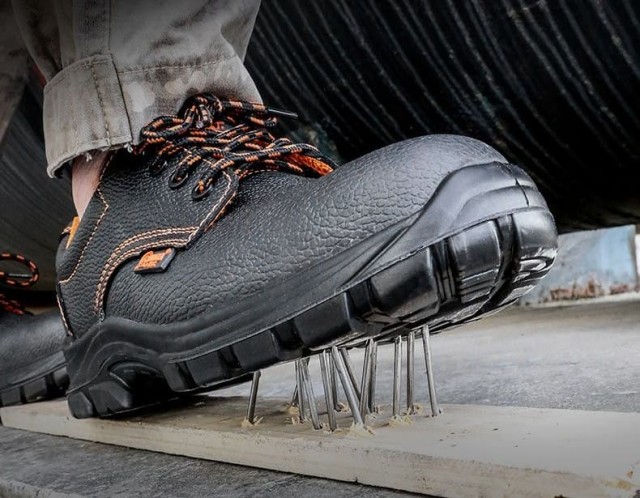When sharp objects like nails, screws, or metal shards litter your worksite, the right footwear can mean the difference between a productive day and a debilitating injury. Puncture-resistant boots are engineered with specialized materials and designs to shield your feet from penetrating hazards—but not all protection is created equal. This guide breaks down how these boots work, what standards really matter, and how to choose the best option for your job’s unique risks.
How Work Boots Protect Against Sole Injuries
Anatomy of Puncture Resistance: From Plates to Outsoles
Puncture-resistant boots incorporate a protective layer—typically steel, composite, or advanced polymers—sandwiched between the insole and outsole. This barrier deflects or absorbs the force of sharp objects, preventing them from piercing through to the foot.
Key components include:
- Midsole Plates: Steel or composite inserts that stop sharp objects at critical penetration points.
- Reinforced Outsoles: Materials like thermoplastic polyurethane (TPU) add durability against abrasion and chemical exposure.
- Seamless Construction: Reduces weak points where debris could enter.
Research shows that designs combining these elements can resist pressures exceeding 1,200 PSI, the equivalent of a 200-pound worker stepping directly onto a nail.
ASTM F2413 vs. Real-World Hazard Scenarios
While ASTM F2413 sets lab-tested benchmarks for puncture resistance (simulating a 270-pound force on a nail), real-world conditions often demand more. For example:
- Construction sites may require thicker plates to handle jagged rebar.
- Waste management workers face uneven pressures from compacted debris.
- Metalworking environments need oil-resistant outsoles to prevent slips alongside puncture protection.
Ask: Does your boot’s protection align with the actual hazards you encounter?
Choosing the Right Protection for Your Job
Steel vs. Composite Plates: Weight, Durability, and Flexibility
| Feature | Steel Plates | Composite Plates |
|---|---|---|
| Weight | Heavier (~30% more) | Lightweight |
| Flexibility | Less flexible | More natural movement |
| Durability | Highly durable | Prone to cracking |
| Best For | Static, high-risk zones | Dynamic, mobile tasks |
Composite materials like Kevlar® or fiberglass suit workers who prioritize agility, while steel remains unmatched for extreme puncture risks.
Industry-Specific Risks: Construction, Waste Management, and Metalworking
- Construction: Opt for boots with deep treads and steel plates to navigate uneven terrain and protruding nails.
- Waste Management: Prioritize chemical-resistant TPU outsoles and full-foot coverage.
- Metalworking: Look for boots that combine puncture resistance with heat insulation.
Beyond the Plate: Additional Features for Total Foot Safety
Impact Absorption and Slip-Resistant Outsoles
Puncture protection is just one layer of safety. Effective boots also integrate:
- Shock-absorbing midsoles to reduce joint strain.
- Oil- and water-resistant treads (tested to ISO 20345’s SR/SRC standards) for stability on slick surfaces.
Maintenance Tips to Preserve Puncture Resistance
- Inspect plates monthly for cracks or deformation.
- Clean outsoles regularly to remove debris that could compromise traction.
- Rotate pairs to extend material lifespan.
Step Into Safety with 3515’s Protective Footwear Solutions
Whether you’re a distributor sourcing bulk orders or a brand owner seeking custom designs, 3515 delivers rigorously tested work boots tailored to your industry’s hazards. Our puncture-resistant designs combine ASTM-compliant protection with ergonomic features to keep workers safe—and productive.
Ready to equip your team with boots that stand up to real-world risks? Partner with 3515 for footwear solutions engineered for durability, comfort, and uncompromising safety.
Related Products
- Durable Leather Safety Boots for Wholesale & Custom OEM Manufacturing
- Wholesale Slip-On Safety Boots Manufacturer - Custom Puncture-Proof & Steel Toe
- Wholesale Durable Mid-Cut Tactical Boots for Custom & Private Label Brands
- Durable Mid-Cut Tactical Boots for Wholesale & Private Label
- Wholesale Customizable Suede Safety Boots - Puncture-Proof with Velcro Closure
Related Articles
- How to Reduce Steel Toe Boot Risks Without Compromising Workplace Safety
- How to Choose Steel Toe Boots: Safety, Comfort, and Job-Specific Features
- Steel Toe Work Boots: Balancing Safety and Comfort for Demanding Jobs
- Matching Men’s Work Shoe Safety Technologies to Workplace Hazards
- Steel Toe Boots vs. Modern Alternatives: Making the Right Safety Choice




















